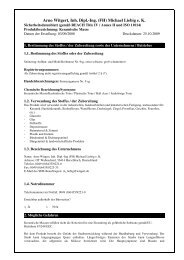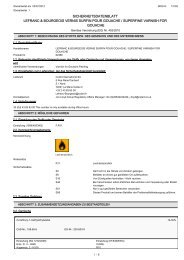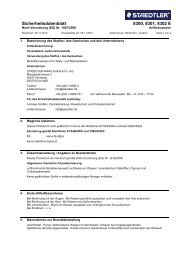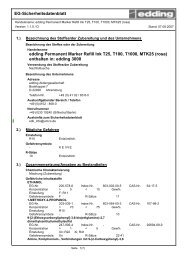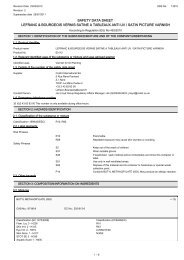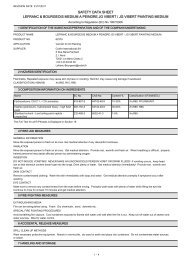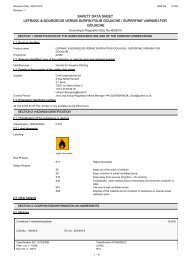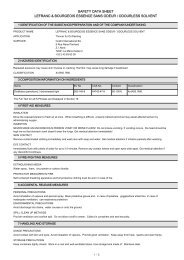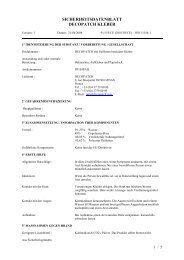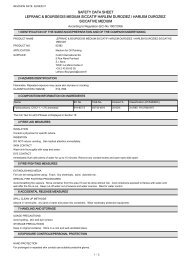MSDS-No. 390436 V002.2 Pattex Kraftkleber Classic Page 3 of 15
Safety Data Sheet according to (EC) No 1907/2006 - Gerstaecker
Safety Data Sheet according to (EC) No 1907/2006 - Gerstaecker
- No tags were found...
Create successful ePaper yourself
Turn your PDF publications into a flip-book with our unique Google optimized e-Paper software.
<strong>MSDS</strong>-<strong>No</strong>.: <strong>390436</strong><br />
<strong>V002.2</strong><br />
<strong>Pattex</strong> <strong>Kraftkleber</strong> <strong>Classic</strong> <strong>Page</strong> 3 <strong>of</strong> <strong>15</strong><br />
Declaration <strong>of</strong> the ingredients according to CLP (EC) <strong>No</strong> 1272/2008:<br />
Hazardous components<br />
CAS-<strong>No</strong>.<br />
Ethyl acetate<br />
141-78-6<br />
Methylcyclohexane<br />
108-87-2<br />
Hydrocarbon aliphatic C4-11 < 0,1%<br />
benzene<br />
64742-49-0<br />
Rosin<br />
8050-09-7<br />
zinc oxide<br />
1314-13-2<br />
n-Hexane<br />
110-54-3<br />
EC Number<br />
REACH-Reg <strong>No</strong>.<br />
205-500-4<br />
01-2119475103-46<br />
203-624-3<br />
01-2119486992-20<br />
content<br />
Classification<br />
>= 25- = 25- = 10- = 0,1- < 1 % Skin sensitizer 1<br />
H317<br />
>= 0,1- < 1 % Acute hazards to the aquatic environment 1<br />
H400<br />
Chronic hazards to the aquatic environment 1<br />
H410<br />
203-777-6 >= 0,1- < 0,5 % Flammable liquids 2<br />
H225<br />
Toxic to reproduction 2<br />
H361f<br />
Aspiration hazard 1<br />
H304<br />
Specific target organ toxicity - repeated<br />
exposure 2<br />
H373<br />
Skin irritation 2<br />
H3<strong>15</strong><br />
Specific target organ toxicity - single<br />
exposure 3<br />
H336<br />
Chronic hazards to the aquatic environment 2<br />
H411<br />
For full text <strong>of</strong> the H - statements and other abbreviations see section 16 "Other information".<br />
Substances without classification may have community workplace exposure limits available.
<strong>MSDS</strong>-<strong>No</strong>.: <strong>390436</strong><br />
<strong>V002.2</strong><br />
<strong>Pattex</strong> <strong>Kraftkleber</strong> <strong>Classic</strong> <strong>Page</strong> 5 <strong>of</strong> <strong>15</strong><br />
5.1. Extinguishing media<br />
Suitable extinguishing media:<br />
carbon dioxide, foam, powder, water spray jet, fine water spray<br />
Extinguishing media which must not be used for safety reasons:<br />
High pressure waterjet<br />
5.2. Special hazards arising from the substance or mixture<br />
In the event <strong>of</strong> a fire, carbon monoxide (CO) and carbon dioxide (CO2) can be released.<br />
5.3. Advice for firefighters<br />
Wear self-contained breathing apparatus.<br />
Wear protective equipment.<br />
Additional information:<br />
Cool endangered containers with water spray jet.<br />
SECTION 6: Accidental release measures<br />
6.1. Personal precautions, protective equipment and emergency procedures<br />
Keep away from sources <strong>of</strong> ignition.<br />
Ensure adequate ventilation.<br />
Danger <strong>of</strong> slipping on spilled product.<br />
6.2. Environmental precautions<br />
Do not empty into drains / surface water / ground water.<br />
6.3. Methods and material for containment and cleaning up<br />
Remove with liquid-absorbing material (sand, peat, sawdust).<br />
Dispose <strong>of</strong> contaminated material as waste according to Chapter 13.<br />
6.4. Reference to other sections<br />
See advice in chapter 8<br />
SECTION 7: Handling and storage<br />
7.1. Precautions for safe handling<br />
Ventilate working rooms thoroughly. Avoid naked flames, sparking and sources <strong>of</strong> ignition. Switch <strong>of</strong>f electrical devices. Do<br />
not smoke, do not weld. Do not empty waste into waste water drains.<br />
Also to be noted when processing larger amounts (> 1 kg): during processing and drying after adhesion, ventilate well. Avoid<br />
all sources <strong>of</strong> fire such as stoves and ovens. Switch <strong>of</strong>f all electrical devices such as parabolic heaters, hot plates, storage<br />
heaters etc. in good time for them to have cooled down before commencing work. Avoid all sparks, including those occurring<br />
at electrical switches and devices.<br />
Hygiene measures:<br />
Wash hands before work breaks and after finishing work.<br />
Do not eat, drink or smoke while working.<br />
7.2. Conditions for safe storage, including any incompatibilities<br />
Keep only in the original container.<br />
Close the container carefully after use and store it at a good ventilated place.<br />
Avoid strictly temperatures below + 5 °C and above + 50 °C.<br />
Do not store together with food or other consumables (c<strong>of</strong>fee, tea, tobacco, etc.).<br />
7.3. Specific end use(s)<br />
Contact adhesive
<strong>MSDS</strong>-<strong>No</strong>.: <strong>390436</strong><br />
<strong>V002.2</strong><br />
<strong>Pattex</strong> <strong>Kraftkleber</strong> <strong>Classic</strong> <strong>Page</strong> 6 <strong>of</strong> <strong>15</strong><br />
SECTION 8: Exposure controls/personal protection<br />
8.1. Control parameters<br />
Valid for<br />
Germany<br />
Ingredient ppm mg/m 3 Type Category Remarks<br />
Ethyl acetate<br />
141-78-6<br />
400 1.500 AGW: 2<br />
If the AGW and BGW values<br />
are complied with, there<br />
should be no risk <strong>of</strong><br />
reproductive damage (see<br />
Number 2.7).<br />
TRGS 900<br />
Ethyl acetate<br />
141-78-6<br />
Short Term Exposure<br />
Classification:<br />
Category I: substances for<br />
which the localized effect has<br />
an assigned OEL or for<br />
substances with a sensitizing<br />
effect in respiratory passages.<br />
TRGS 900<br />
Methylcyclohexane<br />
200 810 AGW: 2 TRGS 900<br />
108-87-2<br />
Methylcyclohexane<br />
Short Term Exposure Category II: substances with a TRGS 900<br />
108-87-2<br />
Classification:<br />
resorptive effect.<br />
Mix <strong>of</strong> hydrocarbons C5-C8 aliphatic 1.500 AGW: 2 TRGS 900<br />
Mix <strong>of</strong> hydrocarbons C5-C8 aliphatic<br />
n-Hexane<br />
110-54-3<br />
n-Hexane<br />
110-54-3<br />
N-HEXANE<br />
110-54-3<br />
Short Term Exposure<br />
Classification:<br />
Category II: substances with a<br />
resorptive effect.<br />
Short Term Exposure Category II: substances with a<br />
Classification:<br />
resorptive effect.<br />
50 180 AGW: 8<br />
If the AGW and BGW values<br />
are complied with, there<br />
should be no risk <strong>of</strong><br />
reproductive damage (see<br />
Number 2.7).<br />
20 72 Time Weighted Average Indicative<br />
(TWA):<br />
TRGS 900<br />
TRGS 900<br />
TRGS 900<br />
ECTLV
<strong>MSDS</strong>-<strong>No</strong>.: <strong>390436</strong><br />
<strong>V002.2</strong><br />
<strong>Pattex</strong> <strong>Kraftkleber</strong> <strong>Classic</strong> <strong>Page</strong> 7 <strong>of</strong> <strong>15</strong><br />
Predicted <strong>No</strong>-Effect Concentration (PNEC):<br />
Name on list<br />
Ethyl acetate<br />
141-78-6<br />
Ethyl acetate<br />
141-78-6<br />
Ethyl acetate<br />
141-78-6<br />
Ethyl acetate<br />
141-78-6<br />
Ethyl acetate<br />
141-78-6<br />
Ethyl acetate<br />
141-78-6<br />
Ethyl acetate<br />
141-78-6<br />
Ethyl acetate<br />
141-78-6<br />
Rosin<br />
8050-09-7<br />
Rosin<br />
8050-09-7<br />
Rosin<br />
8050-09-7<br />
Rosin<br />
8050-09-7<br />
Rosin<br />
8050-09-7<br />
Zinc oxide<br />
1314-13-2<br />
Zinc oxide<br />
1314-13-2<br />
Zinc oxide<br />
1314-13-2<br />
Zinc oxide<br />
1314-13-2<br />
Zinc oxide<br />
1314-13-2<br />
Zinc oxide<br />
1314-13-2<br />
Environmental<br />
Compartment<br />
aqua<br />
(freshwater)<br />
aqua (marine<br />
water)<br />
aqua<br />
(intermittent<br />
releases)<br />
STP<br />
sediment<br />
(freshwater)<br />
sediment<br />
(marine water)<br />
oral<br />
soil<br />
aqua (marine<br />
water)<br />
sediment<br />
(freshwater)<br />
sediment<br />
(marine water)<br />
soil<br />
STP<br />
aqua<br />
(freshwater)<br />
aqua (marine<br />
water)<br />
sediment<br />
(freshwater)<br />
STP<br />
sediment<br />
(marine water)<br />
soil<br />
Exposure<br />
period<br />
Value<br />
mg/l ppm mg/kg others<br />
0,26 mg/L<br />
1,25 mg/kg<br />
0,125<br />
mg/kg<br />
0,24 mg/kg<br />
108 mg/kg<br />
10,8 mg/kg<br />
21,4 mg/kg<br />
146 mg/kg<br />
70,3 mg/kg<br />
44,3 mg/kg<br />
0,026 mg/L<br />
1,65 mg/L<br />
650 mg/L<br />
200 mg/kg<br />
food<br />
0,0005 mg/L<br />
1000 mg/L<br />
25,6 µg/L<br />
7,6 µg/L<br />
64,7 µg/L<br />
Remarks
<strong>MSDS</strong>-<strong>No</strong>.: <strong>390436</strong><br />
<strong>V002.2</strong><br />
<strong>Pattex</strong> <strong>Kraftkleber</strong> <strong>Classic</strong> <strong>Page</strong> 8 <strong>of</strong> <strong>15</strong><br />
Derived <strong>No</strong>-Effect Level (DNEL):<br />
Name on list<br />
Ethyl acetate<br />
141-78-6<br />
Ethyl acetate<br />
141-78-6<br />
Ethyl acetate<br />
141-78-6<br />
Ethyl acetate<br />
141-78-6<br />
Ethyl acetate<br />
141-78-6<br />
Ethyl acetate<br />
141-78-6<br />
Ethyl acetate<br />
141-78-6<br />
Ethyl acetate<br />
141-78-6<br />
Ethyl acetate<br />
141-78-6<br />
Ethyl acetate<br />
141-78-6<br />
Ethyl acetate<br />
141-78-6<br />
Methylcyclohexane<br />
108-87-2<br />
Methylcyclohexane<br />
108-87-2<br />
Methylcyclohexane<br />
108-87-2<br />
Methylcyclohexane<br />
108-87-2<br />
Methylcyclohexane<br />
108-87-2<br />
Rosin<br />
8050-09-7<br />
Rosin<br />
8050-09-7<br />
Rosin<br />
8050-09-7<br />
Rosin<br />
8050-09-7<br />
Application<br />
Area<br />
Route <strong>of</strong><br />
Exposure<br />
Health Effect<br />
worker inhalation Acute/short term<br />
exposure -<br />
systemic effects<br />
worker inhalation Acute/short term<br />
exposure - local<br />
effects<br />
worker dermal Long term<br />
exposure -<br />
systemic effects<br />
worker inhalation Long term<br />
exposure -<br />
systemic effects<br />
worker inhalation Long term<br />
exposure - local<br />
effects<br />
general inhalation Acute/short term<br />
population<br />
exposure -<br />
systemic effects<br />
general<br />
population<br />
general<br />
population<br />
general<br />
population<br />
general<br />
population<br />
general<br />
population<br />
inhalation<br />
dermal<br />
inhalation<br />
oral<br />
inhalation<br />
Acute/short term<br />
exposure - local<br />
effects<br />
Long term<br />
exposure -<br />
systemic effects<br />
Long term<br />
exposure -<br />
systemic effects<br />
Long term<br />
exposure -<br />
systemic effects<br />
Long term<br />
exposure - local<br />
effects<br />
worker dermal Long term<br />
exposure -<br />
systemic effects<br />
worker inhalation Long term<br />
exposure -<br />
systemic effects<br />
general<br />
population<br />
general<br />
population<br />
general<br />
population<br />
dermal<br />
inhalation<br />
oral<br />
Long term<br />
exposure -<br />
systemic effects<br />
Long term<br />
exposure -<br />
systemic effects<br />
Long term<br />
exposure -<br />
systemic effects<br />
worker inhalation Long term<br />
exposure -<br />
systemic effects<br />
general<br />
population<br />
general<br />
population<br />
general<br />
population<br />
inhalation<br />
dermal<br />
oral<br />
Long term<br />
exposure -<br />
systemic effects<br />
Long term<br />
exposure -<br />
systemic effects<br />
Long term<br />
exposure -<br />
systemic effects<br />
Exposure<br />
Time<br />
Value<br />
1468 mg/m3<br />
1468 mg/m3<br />
63 mg/kg<br />
734 mg/m3<br />
734 mg/m3<br />
734 mg/m3<br />
734 mg/m3<br />
37 mg/kg<br />
367 mg/m3<br />
4,5 mg/kg<br />
367 mg/m3<br />
773 mg/kg bw/day<br />
2035 mg/m3<br />
699 mg/kg bw/day<br />
608 mg/m3<br />
699 mg/kg bw/day<br />
176,32 mg/m3<br />
52,174 mg/m3<br />
<strong>15</strong> mg/kg bw/day<br />
<strong>15</strong> mg/kg bw/day<br />
Remarks
<strong>MSDS</strong>-<strong>No</strong>.: <strong>390436</strong><br />
<strong>V002.2</strong><br />
<strong>Pattex</strong> <strong>Kraftkleber</strong> <strong>Classic</strong> <strong>Page</strong> 9 <strong>of</strong> <strong>15</strong><br />
Biological Exposure Indices:<br />
Ingredient Parameters Biological<br />
specimen<br />
n-Hexane<br />
Hexane-2,5- Urine<br />
110-54-3<br />
dione plus<br />
4,5-<br />
Dihydroxy-2-<br />
hexanone<br />
Sampling time Conc. Basis <strong>of</strong> biol.<br />
exposure index<br />
Sampling time: End <strong>of</strong> 5 mg/l DE BAT<br />
shift.<br />
Remark<br />
Additional<br />
Information<br />
8.2. Exposure controls:<br />
Respiratory protection:<br />
Suitable breathing mask when there is inadequate ventilation.<br />
Combination filter: ABEKP<br />
This recommendation should be matched to local conditions.<br />
Hand protection:<br />
Recommended are gloves made from Nitril rubber ( Material thickness >0,1 mm, Perforation time < 30s).Gloves should be<br />
replaced after each short time contact or contamination. Available at laboratory specialized trade or at pharmacies / chemist's<br />
shops.<br />
In the case <strong>of</strong> longer and repeated contact please note that in practice the penetration times may be considerably shorter than<br />
those determined according to EN 374. The protective gloves must always be checked for their suitability for use at the<br />
specific workplace (e.g. mechanical and thermal stress, product compatibility, antistatic effects, etc.). The gloves must be<br />
replaced immediately at the first signs <strong>of</strong> wear and tear. The information provided by the manufacturers and given in the<br />
relevant trade association regulations for industrial safety must always be observed. We recommend that a hand care plan is<br />
drawn up in cooperation with a glove manufacturer and the trade association in accordance with the local operating<br />
conditions.<br />
Perforation time > 10 minutes<br />
material thickness > 0.4 mm<br />
In the case <strong>of</strong> longer contact protective gloves made from nitrile rubber are recommended according to EN 374.<br />
Eye protection:<br />
Goggles which can be tightly sealed.<br />
Skin protection:<br />
Suitable protective clothing<br />
SECTION 9: Physical and chemical properties<br />
9.1. Information on basic physical and chemical properties<br />
Appearance<br />
liquid<br />
highly viscous<br />
beige<br />
Odor<br />
Solvent<br />
pH<br />
Initial boiling point<br />
Flash point<br />
Decomposition temperature<br />
Vapour pressure<br />
Density<br />
()<br />
Bulk density<br />
Viscosity<br />
(Brookfield; speed <strong>of</strong> rotation: 50 min-1;<br />
Spindle <strong>No</strong>: 4)<br />
Viscosity (kinematic)<br />
Explosive properties<br />
Solubility (qualitative)<br />
Solidification temperature<br />
Melting point<br />
Flammability<br />
Auto-ignition temperature<br />
Explosive limits<br />
<strong>No</strong> data available / <strong>No</strong>t applicable<br />
<strong>No</strong> data available / <strong>No</strong>t applicable<br />
-21 °C (-5.8 °F); DIN 51755 Closed cup flash point<br />
<strong>No</strong> data available / <strong>No</strong>t applicable<br />
<strong>No</strong> data available / <strong>No</strong>t applicable<br />
0,84 - 0,88 g/ml<br />
<strong>No</strong> data available / <strong>No</strong>t applicable<br />
1.900 - 2.300 mPa.s<br />
<strong>No</strong> data available / <strong>No</strong>t applicable<br />
<strong>No</strong> data available / <strong>No</strong>t applicable<br />
<strong>No</strong> data available / <strong>No</strong>t applicable<br />
<strong>No</strong> data available / <strong>No</strong>t applicable<br />
<strong>No</strong> data available / <strong>No</strong>t applicable<br />
<strong>No</strong> data available / <strong>No</strong>t applicable<br />
<strong>No</strong> data available / <strong>No</strong>t applicable<br />
<strong>No</strong> data available / <strong>No</strong>t applicable
<strong>MSDS</strong>-<strong>No</strong>.: <strong>390436</strong><br />
<strong>V002.2</strong><br />
<strong>Pattex</strong> <strong>Kraftkleber</strong> <strong>Classic</strong> <strong>Page</strong> 10 <strong>of</strong> <strong>15</strong><br />
Partition coefficient: n-octanol/water<br />
Evaporation rate<br />
Vapor density<br />
Oxidising properties<br />
<strong>No</strong> data available / <strong>No</strong>t applicable<br />
<strong>No</strong> data available / <strong>No</strong>t applicable<br />
<strong>No</strong> data available / <strong>No</strong>t applicable<br />
<strong>No</strong> data available / <strong>No</strong>t applicable<br />
9.2. Other information<br />
<strong>No</strong> data available / <strong>No</strong>t applicable<br />
10.1. Reactivity<br />
<strong>No</strong>ne if used for intended purpose.<br />
10.2. Chemical stability<br />
Stable under recommended storage conditions.<br />
10.3. Possibility <strong>of</strong> hazardous reactions<br />
See section reactivity<br />
10.4. Conditions to avoid<br />
<strong>No</strong>ne if used for intended purpose.<br />
10.5. Incompatible materials<br />
<strong>No</strong>ne if used properly.<br />
10.6. Hazardous decomposition products<br />
<strong>No</strong>ne known<br />
SECTION 10: Stability and reactivity<br />
11.1. Information on toxicological effects<br />
SECTION 11: Toxicological information<br />
General toxicological information:<br />
The preparation is classified based on the conventional method outlined in Article 6(1)(a) <strong>of</strong> Directive 1999/45/EC. Relevant<br />
available health/ecological information for the substances listed under Section 3 is provided in the following.<br />
Inhalative toxicity:<br />
The toxicity <strong>of</strong> the product is due to its narcotic effect after inhalation.<br />
In the event <strong>of</strong> protracted or repeated exposure, damage to health cannot be excluded.<br />
Vapors may cause drowsiness and dizziness.<br />
Skin irritation:<br />
Primary skin irritation: irritating<br />
Eye irritation:<br />
Primary eye irritation: irritating<br />
Sensitizing:<br />
An allergic reaction cannot be excluded after repeated skin contact.<br />
Acute toxicity:<br />
Hazardous components<br />
CAS-<strong>No</strong>.<br />
Ethyl acetate<br />
141-78-6<br />
zinc oxide<br />
1314-13-2<br />
Value<br />
type<br />
Value Route <strong>of</strong><br />
application<br />
Exposure<br />
time<br />
Species<br />
LD50 6.100 mg/kg oral<br />
rat<br />
LC50 200 mg/l inhalation 1 h rat<br />
LD50 > 18.000 mg/kg dermal<br />
rabbit<br />
LD50 > 5.000 mg/kg oral rat<br />
Method
<strong>MSDS</strong>-<strong>No</strong>.: <strong>390436</strong><br />
<strong>V002.2</strong><br />
<strong>Pattex</strong> <strong>Kraftkleber</strong> <strong>Classic</strong> <strong>Page</strong> 11 <strong>of</strong> <strong>15</strong><br />
Skin corrosion/irritation:<br />
Hazardous components<br />
CAS-<strong>No</strong>.<br />
Ethyl acetate<br />
141-78-6<br />
zinc oxide<br />
1314-13-2<br />
Result<br />
Exposure<br />
time<br />
Species<br />
not irritating 24 h rabbit<br />
not irritating<br />
rabbit<br />
Method<br />
Serious eye damage/irritation:<br />
Hazardous components<br />
CAS-<strong>No</strong>.<br />
Ethyl acetate<br />
141-78-6<br />
zinc oxide<br />
1314-13-2<br />
Result<br />
Exposure<br />
time<br />
Species Method<br />
slightly irritating rabbit OECD Guideline 405 (Acute<br />
Eye Irritation / Corrosion)<br />
slightly irritating<br />
rabbit<br />
Respiratory or skin sensitization:<br />
Hazardous components<br />
CAS-<strong>No</strong>.<br />
Ethyl acetate<br />
141-78-6<br />
zinc oxide<br />
1314-13-2<br />
not sensitising<br />
not sensitising<br />
Result Test type Species Method<br />
Guinea pig<br />
maximisat<br />
ion test<br />
Guinea pig<br />
maximisat<br />
ion test<br />
guinea pig<br />
guinea pig<br />
OECD Guideline 406 (Skin<br />
Sensitisation)<br />
OECD Guideline 406 (Skin<br />
Sensitisation)<br />
Germ cell mutagenicity:<br />
Hazardous components<br />
CAS-<strong>No</strong>.<br />
Ethyl acetate<br />
141-78-6<br />
zinc oxide<br />
1314-13-2<br />
n-Hexane<br />
110-54-3<br />
Repeated dose toxicity<br />
Result Type <strong>of</strong> study /<br />
Route <strong>of</strong><br />
administration<br />
negative bacterial reverse<br />
mutation assay (e.g<br />
Ames test)<br />
negative bacterial reverse<br />
mutation assay (e.g<br />
Ames test)<br />
Metabolic<br />
activation /<br />
Exposure time<br />
with and without<br />
with and without<br />
negative inhalation rat<br />
Species<br />
Method<br />
Hazardous components<br />
CAS-<strong>No</strong>.<br />
Ethyl acetate<br />
141-78-6<br />
Ethyl acetate<br />
141-78-6<br />
Result<br />
NOAEL=900<br />
mg/kg<br />
NOAEL=0,002<br />
mg/l<br />
Route <strong>of</strong><br />
application<br />
Exposure time /<br />
Frequency <strong>of</strong><br />
treatment<br />
oral: gavage 90 d daily rat<br />
inhalation 90 d continuous rat<br />
Species<br />
Method<br />
SECTION 12: Ecological information<br />
General ecological information:<br />
The preparation is classified based on the conventional method outlined in Article 6(1)(a) <strong>of</strong> Directive 1999/45/EC. Relevant<br />
available health/ecological information for the substances listed under Section 3 is provided in the following.<br />
Do not empty into drains / surface water / ground water.<br />
Toxic to aquatic organisms<br />
May cause long-term adverse effects in the aquatic environment.
<strong>MSDS</strong>-<strong>No</strong>.: <strong>390436</strong><br />
<strong>V002.2</strong><br />
<strong>Pattex</strong> <strong>Kraftkleber</strong> <strong>Classic</strong> <strong>Page</strong> 12 <strong>of</strong> <strong>15</strong><br />
12.1. Toxicity<br />
Hazardous components<br />
CAS-<strong>No</strong>.<br />
Ethyl acetate<br />
141-78-6<br />
Ethyl acetate<br />
141-78-6<br />
Ethyl acetate<br />
141-78-6<br />
Methylcyclohexane<br />
108-87-2<br />
Hydrocarbon aliphatic C4-11<br />
< 0,1% benzene<br />
64742-49-0<br />
Hydrocarbon aliphatic C4-11<br />
< 0,1% benzene<br />
64742-49-0<br />
Hydrocarbon aliphatic C4-11<br />
< 0,1% benzene<br />
64742-49-0<br />
Rosin<br />
8050-09-7<br />
Rosin<br />
8050-09-7<br />
Rosin<br />
8050-09-7<br />
zinc oxide<br />
1314-13-2<br />
zinc oxide<br />
1314-13-2<br />
n-Hexane<br />
110-54-3<br />
n-Hexane<br />
110-54-3<br />
n-Hexane<br />
110-54-3<br />
Value<br />
type<br />
Value<br />
Acute<br />
Toxicity<br />
Study<br />
Exposure<br />
time<br />
Species<br />
LC50 270 mg/l Fish 48 h Leuciscus idus melanotus<br />
Method<br />
EC50 164 mg/l Daphnia 48 h Daphnia cucullata OECD Guideline<br />
202 (Daphnia sp.<br />
Acute<br />
Immobilisation<br />
Test)<br />
EC50 > 2.000 mg/l Algae 96 h Selenastrum capricornutum<br />
(new name: Pseudokirchnerella<br />
subcapitata)<br />
OECD Guideline<br />
201 (Alga, Growth<br />
Inhibition Test)<br />
EC50 147.000 mg/l Daphnia 48 h Daphnia magna OECD Guideline<br />
202 (Daphnia sp.<br />
Acute<br />
Immobilisation<br />
Test)<br />
LC50 1 - 10 mg/l Fish OECD Guideline<br />
203 (Fish, Acute<br />
Toxicity Test)<br />
EC50 3 mg/l Daphnia 48 h Daphnia magna OECD Guideline<br />
202 (Daphnia sp.<br />
Acute<br />
Immobilisation<br />
Test)<br />
EC50 1 - 10 mg/l Algae OECD Guideline<br />
201 (Alga, Growth<br />
Inhibition Test)<br />
LC50 > 1.000 mg/l Fish 96 h Pimephales promelas OECD Guideline<br />
203 (Fish, Acute<br />
Toxicity Test)<br />
EC50 911 mg/l Daphnia 48 h Daphnia magna OECD Guideline<br />
202 (Daphnia sp.<br />
Acute<br />
Immobilisation<br />
Test)<br />
EC50 > 100 mg/l Algae 72 h Scenedesmus subspicatus (new<br />
name: Desmodesmus<br />
subspicatus)<br />
LC50 > 1.000 mg/l Fish Leuciscus idus OECD Guideline<br />
203 (Fish, Acute<br />
Toxicity Test)<br />
EC50 0,17 mg/l Algae 72 h Selenastrum capricornutum<br />
(new name: Pseudokirchnerella<br />
subcapitata)<br />
OECD Guideline<br />
201 (Alga, Growth<br />
Inhibition Test)<br />
LC50 1 - 10 mg/l Fish OECD Guideline<br />
203 (Fish, Acute<br />
Toxicity Test)<br />
EC50 2,1 mg/l Daphnia 48 h Daphnia magna OECD Guideline<br />
202 (Daphnia sp.<br />
Acute<br />
Immobilisation<br />
Test)<br />
EC50 1 - 10 mg/l Algae OECD Guideline<br />
201 (Alga, Growth<br />
Inhibition Test)<br />
12.2. Persistence and degradability<br />
Hazardous components<br />
CAS-<strong>No</strong>.<br />
Result<br />
Route <strong>of</strong><br />
application<br />
Degradability<br />
Method
<strong>MSDS</strong>-<strong>No</strong>.: <strong>390436</strong><br />
<strong>V002.2</strong><br />
Ethyl acetate<br />
141-78-6<br />
Rosin<br />
8050-09-7<br />
n-Hexane<br />
110-54-3<br />
<strong>Pattex</strong> <strong>Kraftkleber</strong> <strong>Classic</strong> <strong>Page</strong> 13 <strong>of</strong> <strong>15</strong><br />
readily biodegradable aerobic 100 % OECD Guideline 301 D (Ready<br />
Biodegradability: Closed Bottle<br />
Test)<br />
aerobic 36 - 46 % OECD Guideline 301 F (Ready<br />
Biodegradability: Manometric<br />
Respirometry Test)<br />
readily biodegradable aerobic > 60 %<br />
12.3. Bioaccumulative potential / 12.4. Mobility in soil<br />
Hazardous components<br />
CAS-<strong>No</strong>.<br />
Ethyl acetate<br />
141-78-6<br />
Methylcyclohexane<br />
108-87-2<br />
n-Hexane<br />
110-54-3<br />
LogKow Bioconcentration<br />
factor (BCF)<br />
Exposure<br />
time<br />
Species Temperature Method<br />
0,6 OECD Guideline 107<br />
(Partition Coefficient (noctanol<br />
/ water), Shake<br />
Flask Method)<br />
3,61<br />
4<br />
SECTION 13: Disposal considerations<br />
13.1. Waste treatment methods<br />
Product disposal:<br />
Dispose <strong>of</strong> waste and residues in accordance with local authority requirements.<br />
Disposal <strong>of</strong> uncleaned packages:<br />
Use packages for recycling only when totally empty.<br />
Waste code<br />
08 04 09 waste adhesives and sealants containing organic solvents and other dangerous substances<br />
Road transport ADR:<br />
SECTION 14: Transport information<br />
Class: 3<br />
Packaging group:<br />
II<br />
Classification code:<br />
F1<br />
Hazard ident. number: 33<br />
UN no.: 1133<br />
Label: 3<br />
Technical name:<br />
ADHESIVES<br />
Tunnelcode:<br />
(D/E)<br />
Additional information:<br />
Special provision 640D<br />
Additional substance property:<br />
Environmentally Hazardous<br />
Railroad transport RID:<br />
Class: 3<br />
Packaging group:<br />
II<br />
Classification code:<br />
F1<br />
Hazard ident. number: 33<br />
UN no.: 1133<br />
Label: 3<br />
Technical name:<br />
ADHESIVES<br />
Tunnelcode:<br />
Additional information:<br />
Special provision 640D<br />
Additional substance property:<br />
Environmentally Hazardous
<strong>MSDS</strong>-<strong>No</strong>.: <strong>390436</strong><br />
<strong>V002.2</strong><br />
<strong>Pattex</strong> <strong>Kraftkleber</strong> <strong>Classic</strong> <strong>Page</strong> 14 <strong>of</strong> <strong>15</strong><br />
Inland water transport ADN:<br />
Class: 3<br />
Packaging group:<br />
II<br />
Classification code:<br />
F1<br />
Hazard ident. number:<br />
UN no.: 1133<br />
Label: 3<br />
Technical name:<br />
ADHESIVES<br />
Additional information:<br />
Special provision 640D<br />
Additional substance property:<br />
Environmentally Hazardous<br />
Marine transport IMDG:<br />
Class: 3<br />
Packaging group:<br />
II<br />
UN no.: 1133<br />
Label: 3<br />
EmS:<br />
F-E ,S-D<br />
Seawater pollutant:<br />
Marine pollutant<br />
Proper shipping name:<br />
ADHESIVES (Methylcyclohexane)<br />
Air transport IATA:<br />
Class: 3<br />
Packaging group:<br />
II<br />
Packaging instructions (passenger) 353<br />
Packaging instructions (cargo) 364<br />
UN no.: 1133<br />
Label: 3<br />
Proper shipping name:<br />
Adhesives<br />
SECTION <strong>15</strong>: Regulatory information<br />
<strong>15</strong>.1. Safety, health and environmental regulations/legislation specific for the substance or mixture<br />
VOC content<br />
62,43 %<br />
(VOCV 814.018 VOC regulation<br />
CH)<br />
National regulations/information (Germany):<br />
WGK: 2, water-endangering product. (German VwVwS <strong>of</strong> May 17, 1999 )<br />
Classification in conformity with the calculation method<br />
Storage class VCI: 3
<strong>MSDS</strong>-<strong>No</strong>.: <strong>390436</strong><br />
<strong>V002.2</strong><br />
<strong>Pattex</strong> <strong>Kraftkleber</strong> <strong>Classic</strong> <strong>Page</strong> <strong>15</strong> <strong>of</strong> <strong>15</strong><br />
SECTION 16: Other information<br />
The labelling <strong>of</strong> the product is indicated in Section 2. The full text<br />
<strong>of</strong> all abbreviations indicated by codes in this safety data sheet are as follows:<br />
R11 Highly flammable.<br />
R36 Irritating to eyes.<br />
R38 Irritating to skin.<br />
R43 May cause sensitisation by skin contact.<br />
R48/20 Harmful: danger <strong>of</strong> serious damage to health by prolonged exposure through inhalation.<br />
R50/53 Very toxic to aquatic organisms, may cause long-term adverse effects in the aquatic environment.<br />
R51/53 Toxic to aquatic organisms, may cause long-term adverse effects in the aquatic environment.<br />
R62 Possible risk <strong>of</strong> impaired fertility.<br />
R65 Harmful: may cause lung damage if swallowed.<br />
R66 Repeated exposure may cause skin dryness or cracking.<br />
R67 Vapours may cause drowsiness and dizziness.<br />
H225 Highly flammable liquid and vapour.<br />
H304 May be fatal if swallowed and enters airways.<br />
H3<strong>15</strong> Causes skin irritation.<br />
H317 May cause an allergic skin reaction.<br />
H319 Causes serious eye irritation.<br />
H336 May cause drowsiness or dizziness.<br />
H361f Suspected <strong>of</strong> damaging fertility.<br />
H373 May cause damage to organs through prolonged or repeated exposure.<br />
H400 Very toxic to aquatic life.<br />
H410 Very toxic to aquatic life with long lasting effects.<br />
H411 Toxic to aquatic life with long lasting effects.<br />
Further information:<br />
This information is based on our current level <strong>of</strong> knowledge and relates to the product in the state in which it is delivered. It is<br />
intended to describe our products from the point <strong>of</strong> view <strong>of</strong> safety requirements and is not intended to guarantee any<br />
particular properties.



